What is sciatica?
Sciatica is a condition that occurs when the sciatic nerve, the body’s longest and thickest nerve, becomes irritated and compressed. Sciatica comprises five nerve roots, two from the lumbar spine and three from the final section of the spine called the spectrum. These five nerve roots form a left and right sciatic nerve. On each side of the body, one sciatic nerve travels from the lower back through the hips and buttocks and down to the legs and the feet. Sciatica causes pain and discomfort in those areas.
What causes sciatica pain?
Sciatica pain is caused by irritation or compression of the sciatic nerve. The most common cause of sciatica is a herniated disc in the lumbar spine that presses on the nerve roots that make up the sciatic nerve. Other causes of sciatica include:
- Spinal stenosis: spinal canal narrowing that places pressure on the nerve roots.
- Degenerative disc disease: A condition where the discs between the vertebrae deteriorate and cause pressure on the nerve roots.
- Piriformis syndrome: A condition where the piriformis muscle in the glutes presses on the sciatic nerve.
- Trauma/spinal injury: This can cause compression and irritation to the nerve roots.
- Spondylolisthesis: A condition where one vertebra slips out of place, putting pressure on the nerve roots.
How does the core affect/contribute to sciatica pain?
The core affects almost every aspect of our body alignment, including our shoulders, hips, knees, and feet. The core includes the many stabilizer muscles around your torso, back, hip flexors, and glutes.
Weakness in your core and glutes can contribute to improper body mechanics and alignment, affecting your entire body. These imbalances make you more susceptible to injury, including lumbar disc herniations that produce sciatica pain. Two people in the same automobile accident, for instance, could suffer (or not suffer) different injuries depending on their core strength. The person with a strong core and good alignment could walk away unscathed, while someone with a weak core and poor alignment could endure the type of lumbar disc herniations that produce sciatica pain.
How can yoga help with sciatica pain?
Because sciatica pain isn’t only the result of tightness and weakness in the lower back and legs, it’s vital to incorporate an effective strength-based yoga routine that uses targeted strengthening exercises, stretches, and mobility work to help alleviate and fix the causes of sciatica pain.
Lower back pain and susceptibility to sciatica issues are caused by tightness in your hips, hamstrings, and glutes, so stretching these muscles can alleviate these contributing factors. That’s why yoga is so important.
Many stretches found in yoga can relieve tension in these areas, thus reducing and relieving the symptoms of lower back and sciatica issues. However, you want to be careful not to overstretch because this can lead to further injury. You should feel a pleasant stretch or minor discomfort but no sharp pains.
I’ll share some of my favorite stretches below.
Yoga develops strength in areas of weakness.
Weakness and imbalances in the muscles from your shoulders to your ankles can contribute to tight hips, hamstrings, and glutes, producing a kinetic chain of pain that results in lower back issues, making you more susceptible to sciatic and other ailments.
A great low-impact way to develop strength while avoiding further injuries is strength-based yoga paired with specific physical therapy exercises to strengthen your shoulders, midsection, and hips. I’ll cover these movements in more detail below.
Yoga poses for sciatica:
Plank: This straightforward but challenging movement builds core stability and strength through your shoulders, core, and hips. Lie in a pushup position with forearms resting on the floor, elbows under shoulders, and bent 90 degrees. Push off the elbows, tucking your chin, so your head aligns with your body. Keep head inline with spine and belly button drawn in. Hold for 20 seconds, rest for a minute, and repeat.
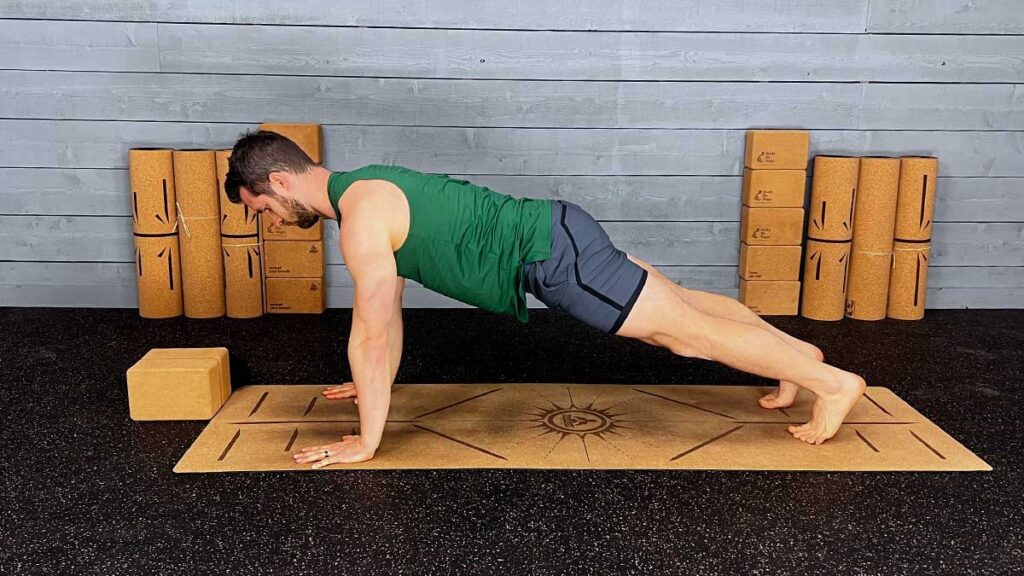
Bird Dog: From a tabletop position, extend one arm and the opposite leg. Breathe in to lengthen and strengthen the body. Keep the thumb up on the extended arm. Squeeze the abs on the exhale. Switch legs.

Cobra: Lie prone (face down) on the ground or floor. Squeeze your glutes and bring your shoulder blades back and down. With thumbs pointed up, arms externally rotated, and chin tucked, lift your chest and hold for 2 seconds. Use your core and hips, not your lower back, and maintain control over your breathing.
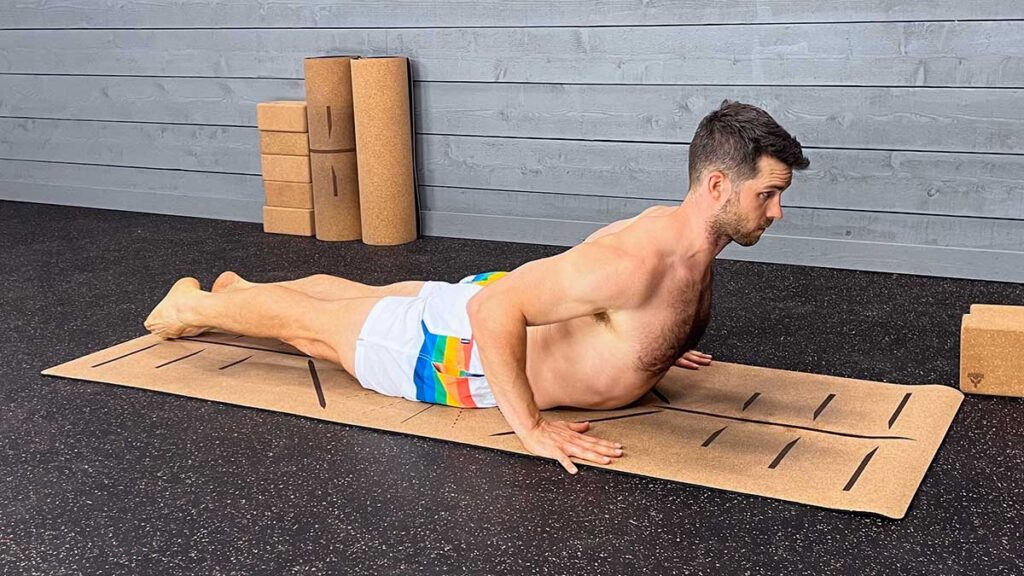
Pigeon: This move is one of the best hip openers, which improves core strength. From a plank position, bend your right knee. Lift your right foot and draw the right knee toward the right elbow as if stepping between your arms. But instead of placing your foot on the ground, rotate your right knee out, resting it on the ground just outside your right hand. Hold for a five-count and switch legs.
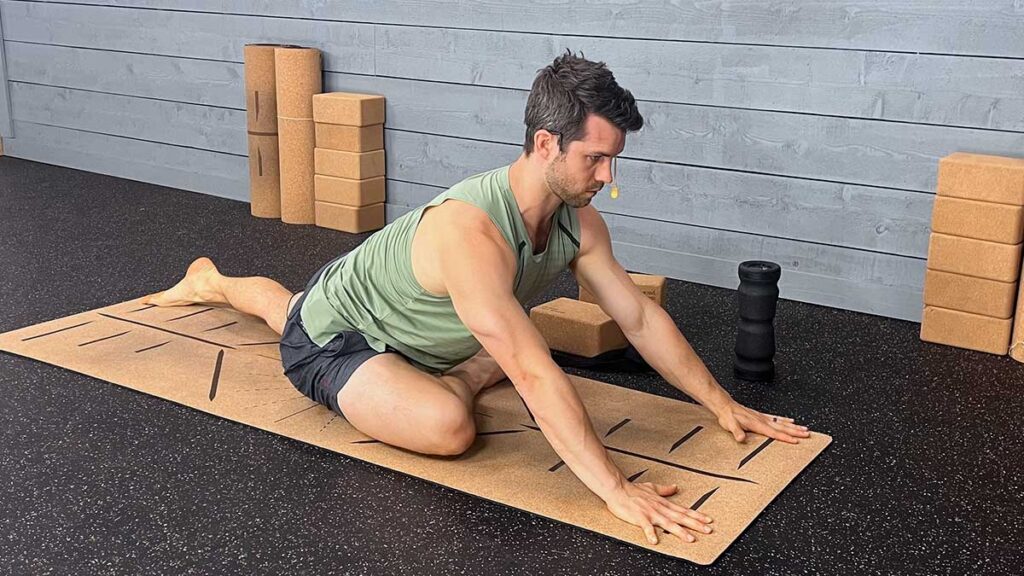
Child’s Pose: This movepose is effective for stretching out the shoulders, which hunch over from too much sitting and contribute to lower back pain and sciatica.From a kneeling position, touch your big toes together and sit on your heels. Separate your knees about hip-width apart and lay your torso between your thighs. Place your hands on the floor along your torso, palms up, and release the fronts of your shoulders toward the floor. You should feel the weight of the front of the shoulders pulling the shoulder blades wide across your back.Hold the pose for 30 seconds, pause for 10, and hold for another 30 seconds. Repeat.
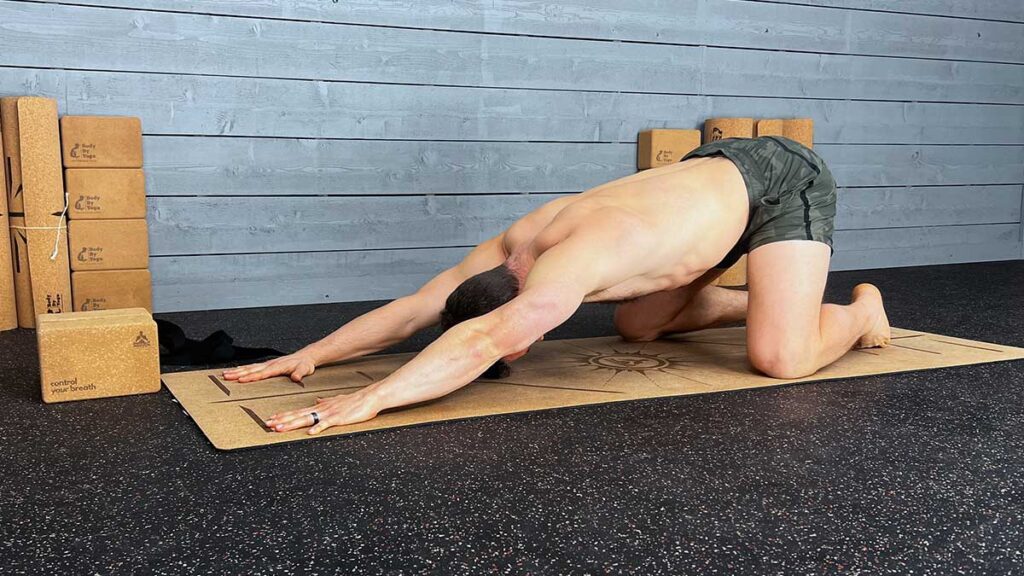
Cat/Cow: This two-part move improves lumbar and cervical spine flexibility.Start on all fours with hands beneath your shoulders and knees on the ground. Inhale, dropping your chest as you push your hips and shoulder blades back into cow position. Lift your chin and chest and gaze forward. For the cat, exhale as you draw your belly button to your spine and round your back toward the ceiling like a cat.
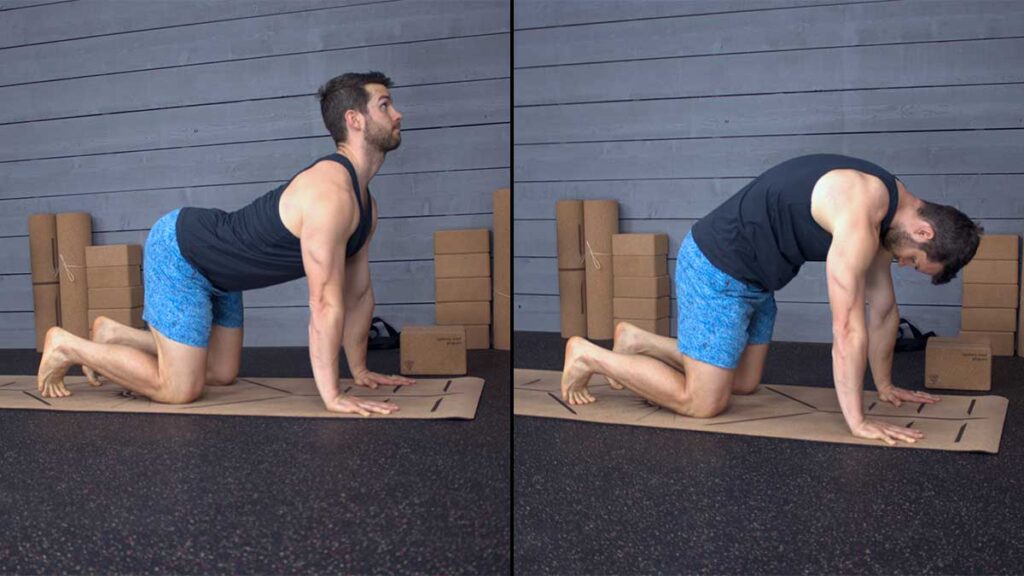
Glute Bridge: Lie face up on the floor with knees bent 90 degrees and feet on the floor. Squeeze your glutes and bridge your hips to the ceiling. Only your shoulders and hips remain on the ground. Hold for two seconds, then lower your hips toward the ground without touching. Once you’ve mastered the standard version of the glute bridge, try it with one leg straight and in line with your torso and your weight supported on the other leg. Switch legs.
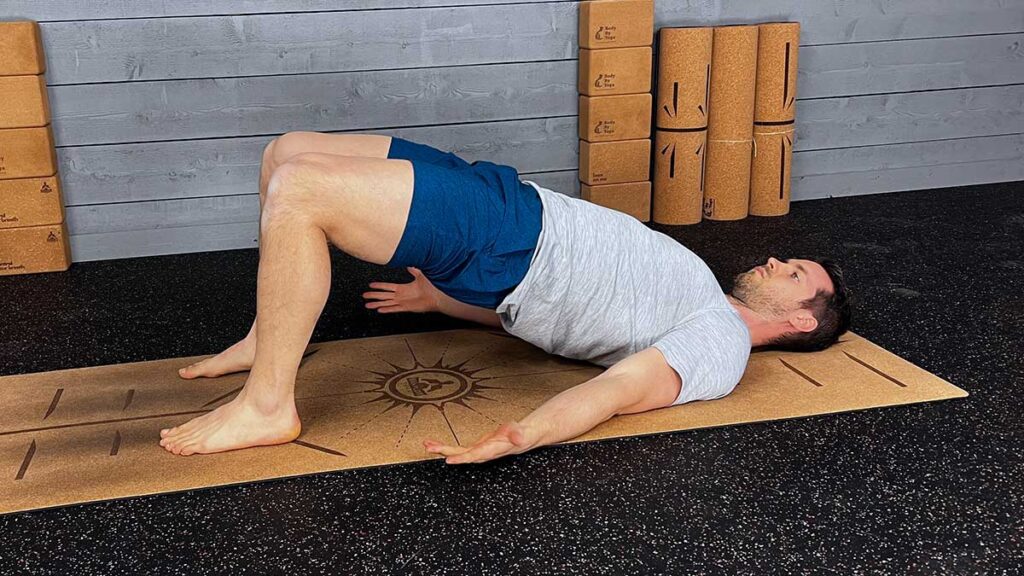
90/90 Stretch:
Sit on the floor and bend one leg in front of your body with your hip rotated out. Position yourself so your lower leg and knee are on the ground. Your leg should form a 90-degree angle, and make sure your ankle is neutral and your foot is pointing straight.
Position the other leg beside you. Rotate your hip inward with your shin and ankle on the ground. Bend your knee to form a 90-degree angle. Your back knee should be in line with your hip, and your ankle should be neutral.
Keep your back straight and try not to bend to either side. Try sitting into both hips and easing the lifted hip straight down toward the ground.
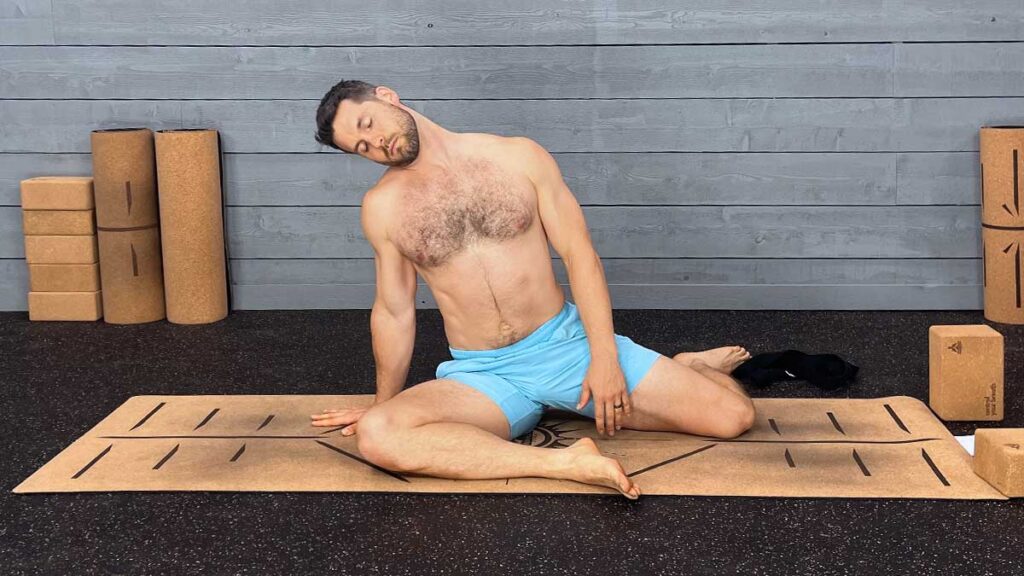
Downward Dog: Ever seen a dog with sciatica issues? From your hands and knees, move your hands out from under your shoulders, so your arms are extended at roughly a 45-degree angle. Tuck your toes under your feet. As you exhale, straighten your legs and lift your butt and midsection toward the ceiling. Your knees are slightly bent, and you’re up on your toes. Now drop your head between your arms, straighten your arms and legs, and push back on your feet. Press your heels into the floor – or as far as you can. Hold for two seconds.

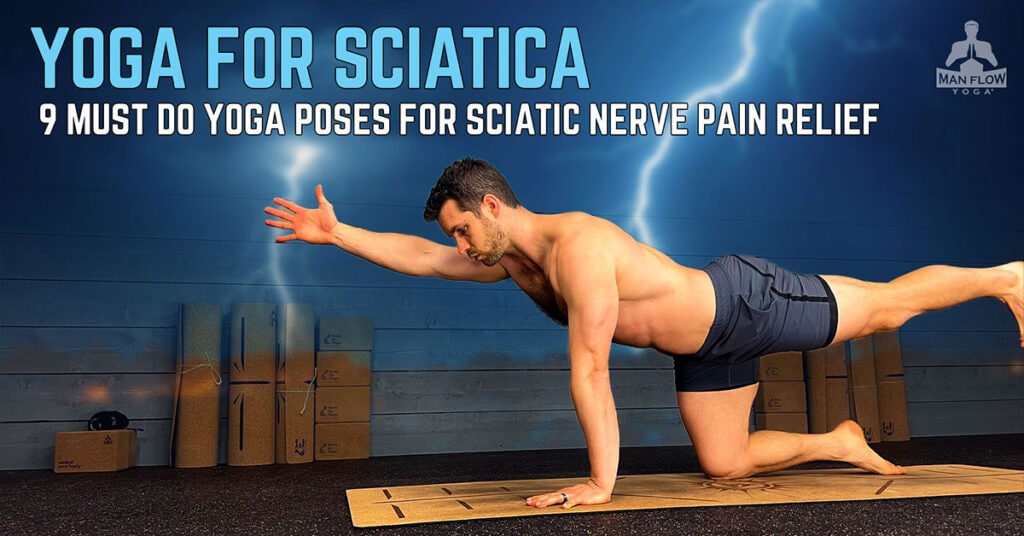

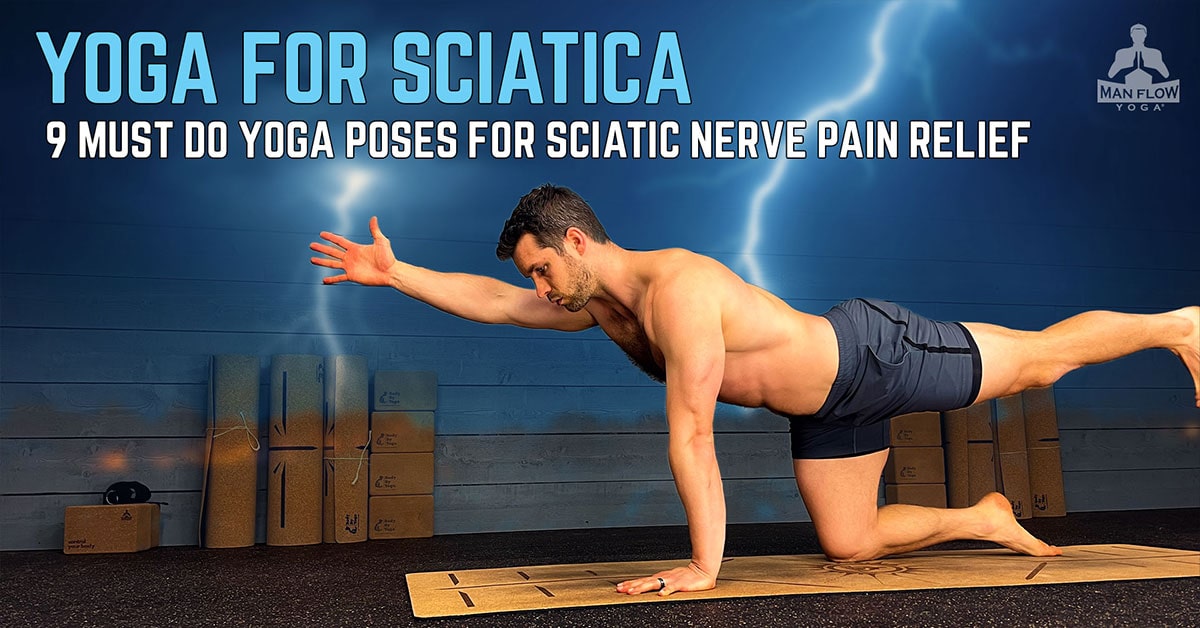
I have been a subscriber, but now considering the paid subscription. I am 63 and had a total right knee replacement in December of 2022. Now trying to get back to normal, but experiencing swelling, stiffness and aches in my quads, lower leg and lower back. Looking for an program to gain flexibility and strength. There are some constraints on 120 degree bend of implant and kneeling. I am 6’1” and 170 lbs and in reasonable shape. What do you think?
We actually have a program called Bulletproof Your Knees that woudl be beneficial to you. It was created with physical therapy in mind and you can access it for Free for 7-Days to see if it works for you:
https://manflowyoga.tv/programs/collection-bulletproof-your-knees?
Hey the writing and the picture for 90 90 don’t seem to match or am I missing the point
Thanks these are helping with mine. Now all I need is to increase rotation between hips and shoulders
Thank you for the heads up Paul, we’ll look into it!
What are your thoughts / comments on drop foot and toe cramps? Can that be related to sciatica?
Great question Jaime. The short answer is yes. Indirectly but not directly.
Thanks Dean. This is very. helpful–and even more helpful would be to do this in a routine with instruction, instead of still pics and written directions. Best, Jerry
Thank you for the feedback Jerry! If you’re looking for routines similar to what you found in this article, you should consider a Free 7-Day Trial to our Member’s Area, App, and Workout Library:
https://manflowyoga.com/seven-day-trial/